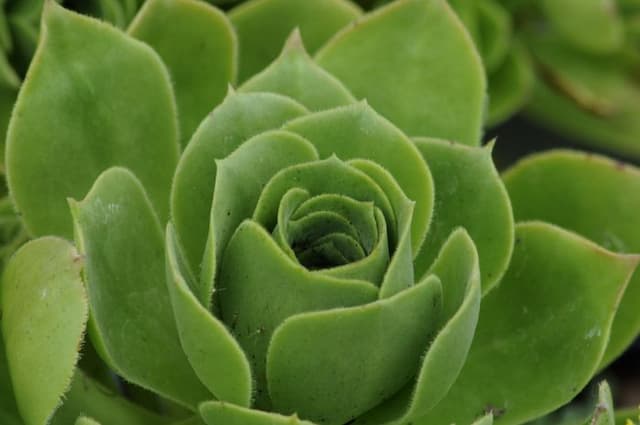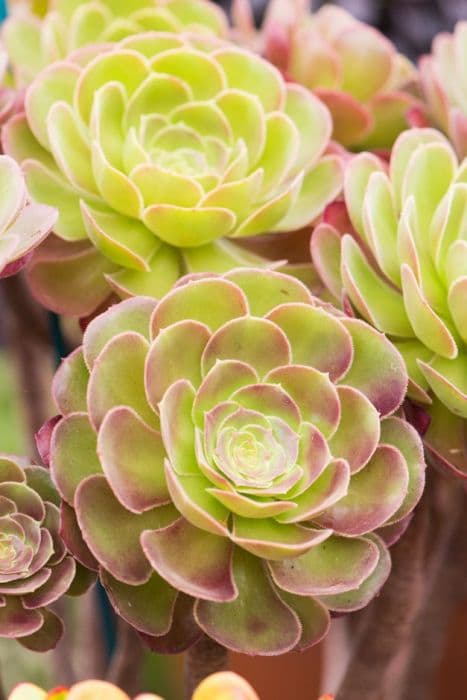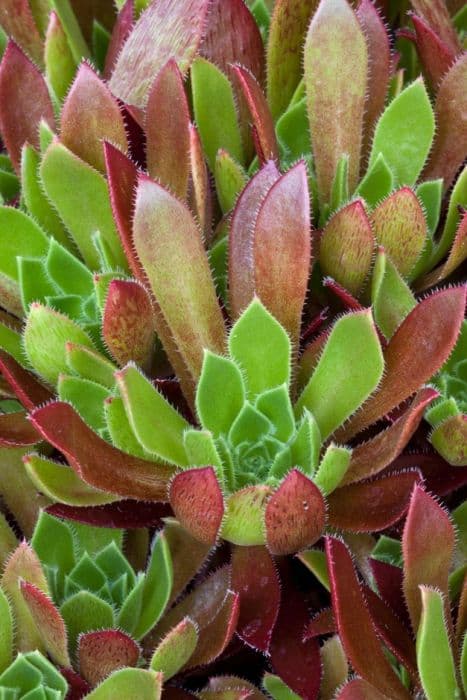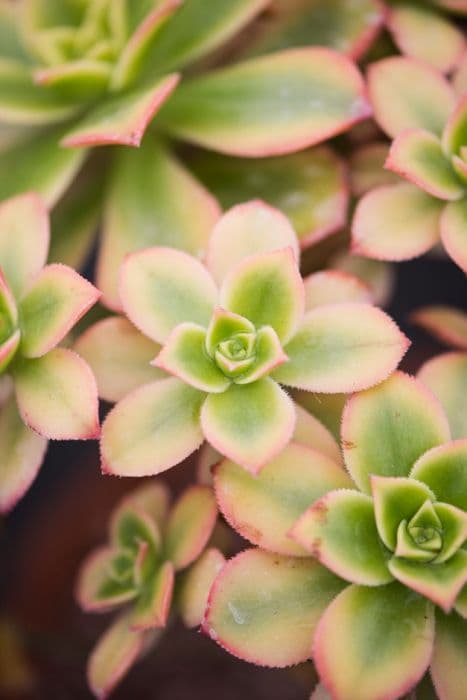Dragon's Blood Stonecrop Sedum spurium 'Fuldaglut'
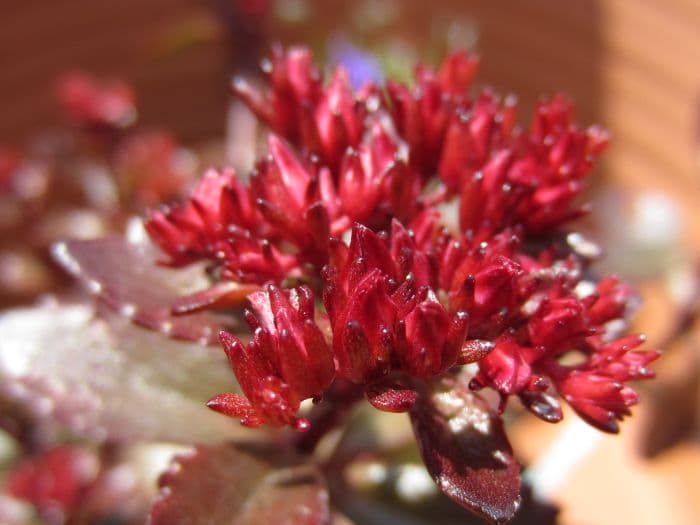
ABOUT
Sedum spurium 'Fuldaglut', commonly known as 'Fuldaglut' stonecrop, is a dense, mat-forming perennial that boasts succulent leaves and clusters of star-shaped flowers. The foliage exhibits a vibrant and dynamic color range—starting as deep green and graduating to bronze-red tones, especially in response to cooler temperatures of fall or stress conditions. When this plant blooms, typically in the summer months, it becomes adorned with small, brilliant pink flowers that are tightly packed together and rise slightly above the foliage. The leaves are fleshy and rounded, with edges that may be slightly scalloped, creating a textured appearance. This stonecrop variety, with its trailing habit and colorful presence, makes it a popular choice for ground cover, rock gardens, borders, or cascading over walls. Its drought-resistant nature is enhanced by the water-retentive properties of its leaves, adding to its hardiness and low-maintenance appeal.
About this plant
 Names
NamesFamily
Crassulaceae.
Synonyms
Two-Row Stonecrop, Dragon's Blood Stonecrop, Caucasian Stonecrop, Creeping Sedum.
Common names
Phedimus spurius 'Fuldaglut', Sedum spurium 'Fuldaglut'.
 Toxicity
ToxicityTo humans
Two-row stonecrop (Sedum spurium 'Fuldaglut') is generally considered non-toxic to humans. Ingesting this plant is unlikely to cause any severe symptoms of poisoning. However, it is always prudent to avoid ingesting plants that are not intended for human consumption, as individual sensitivities can vary. If large amounts are ingested, gastrointestinal discomfort or irritation could possibly occur.
To pets
Two-row stonecrop (Sedum spurium 'Fuldaglut') is generally considered non-toxic to pets, including dogs and cats. It does not typically cause serious symptoms if ingested by pets. However, as with humans, individual animals may have sensitivities or allergic reactions to this plant, and ingestion should still be avoided. If a pet were to ingest large quantities, mild gastrointestinal upset could potentially occur.
 Characteristics
CharacteristicsLife cycle
Perennials
Foliage type
Evergreen
Color of leaves
Reddish
Flower color
Pink
Height
6 inches (15 cm)
Spread
18 inches (45 cm)
Plant type
Succulent
Hardiness zones
3
Native area
Caucasus
Benefits
 General Benefits
General Benefits- Drought Tolerance: Sedum spurium 'Fuldaglut', or Dragon's Blood Stonecrop, is highly resistant to drought once established, requiring minimal watering and care.
- Low Maintenance: This plant requires very little maintenance, making it ideal for gardeners who seek a low-effort, yet visually appealing ground cover.
- Erosion Control: Its dense mat-forming habit helps prevent soil erosion on slopes and in rocky areas.
- Attracts Pollinators: The blossoms of Dragon's Blood Stonecrop attract bees, butterflies, and other beneficial insects, supporting biodiversity.
- Hardy Nature: It is hardy and can survive in a wide range of temperatures and is resistant to many plant diseases.
- Seasonal Interest: Provides year-round visual interest with its changing foliage colors and summer flowers, adding aesthetic value to the landscape.
- Rapid Growth: This plant spreads quickly, meaning it can cover large areas in a relatively short amount of time, providing quick results for gardeners.
- Soil Tolerance: It can thrive in poor soil conditions, including rocky and sandy soils, where other plants might not survive.
- Winter Interest: Its foliage sometimes changes to a deep red or burgundy in the fall and winter, adding color to otherwise dormant gardens.
 Medical Properties
Medical PropertiesThis plant is not used for medical purposes.
 Air-purifying Qualities
Air-purifying QualitiesThis plant is not specifically known for air purifying qualities.
 Other Uses
Other Uses- Sedum spurium 'Fuldaglut', also known as Dragon's Blood Stonecrop, can be used to create a living roof or green roof, providing insulation and reducing rainwater runoff.
- Dragon's Blood Stonecrop is an excellent ground cover that can stabilize soil on slopes, preventing erosion and landslides.
- This plant is used in xeriscaping, landscaping designed to reduce or eliminate the need for supplemental water from irrigation.
- Dragon's Blood Stonecrop can be planted in crevices of walls or walkways, adding greenery to hard-to-plant areas.
- The plant is suitable for fairy gardens or miniature landscaping projects due to its small size and attractive appearance.
- Dragon's Blood Stonecrop is often used to add contrast in rock gardens because of its vibrant red foliage.
- Due to its drought tolerance, it is a popular choice for firewise landscaping, reducing the risk of fire near homes.
- It is used to add season-long interest in container gardens, as it remains vibrant from spring to frost.
- Dragon's Blood Stonecrop, with its succulent leaves and sprawling habit, can be utilized as a living mulch to suppress weeds and retain soil moisture.
- This plant is sometimes planted around the base of taller plants or shrubs to create a layered, textured garden effect.
Interesting Facts
 Feng Shui
Feng ShuiThe plant Sedum is not used in Feng Shui practice.
 Zodiac Sign Compitability
Zodiac Sign CompitabilitySedum is not used in astrology practice.
 Plant Symbolism
Plant Symbolism- Endurance: Sedum spurium 'Fuldaglut', commonly known as Dragon's Blood Stonecrop, is a hardy plant that can survive in tough conditions. Its ability to thrive with minimal care symbolizes endurance and resilience.
- Persistence: The plant's growth habit, spreading steadily and persistently, embodies qualities of determination and the ability to overcome obstacles.
- Vitality: With its vibrant reddish foliage that intensifies in color throughout the season, Dragon's Blood Stonecrop represents life force and vitality.
- Adaptability: Dragon's Blood Stonecrop can adapt to various soil types and levels of sunlight, symbolizing versatility and flexibility in life.
- Protection: In some cultures, ground-covering plants like Dragon's Blood Stonecrop are thought to offer a protective ground shield, warding off negativity and harm.
 Water
WaterDragon's Blood Stonecrop should be watered deeply but infrequently, allowing the soil to dry out completely between waterings. As a succulent, it is drought-tolerant and overwatering can lead to root rot. During the active growing season in spring and summer, watering once every 7-10 days with approximately a quarter to half a gallon per square yard should suffice, depending on the size of your plant and the environmental conditions. During the fall and winter, reduce watering to once every 2-3 weeks, or even less if it's in a cool or humid environment. Always check the top inch of soil for dryness before watering again.
 Light
LightDragon's Blood Stonecrop thrives in full sun to light shade conditions. The ideal location for this plant is a spot where it can receive at least 6 hours of sunlight a day. If planted indoors, a south-facing window is typically the best spot. However, in extremely hot climates, some afternoon shade can prevent scorching of the leaves.
 Temperature
TemperatureDragon's Blood Stonecrop prefers temperatures ranging between 65-75 degrees Fahrenheit, but it can tolerate a range from just above freezing to 90 degrees Fahrenheit. However, for optimal growth, keeping it within the preferred temperature range is recommended. It is a hardy plant that can survive winter conditions as long as the soil is well-draining to prevent root rot.
 Pruning
PruningPruning Dragon's Blood Stonecrop is primarily done to maintain shape, encourage bushier growth, or remove any damaged or dead foliage. It can be pruned back in early spring before new growth starts. Pruning is not frequently required but doing it annually can help rejuvenate the plant and keep it looking tidy.
 Cleaning
CleaningNot needed
 Soil
SoilDragon's Blood Stonecrop requires well-draining soil, with a gritty composition such as a mix of potting soil, coarse sand, and perlite or pumice. An ideal pH level for this plant is around 6.0 to 7.5.
 Repotting
RepottingDragon's Blood Stonecrop doesn't need frequent repotting as it thrives on neglect, typically every 2-3 years or when it outgrows its container.
 Humidity & Misting
Humidity & MistingDragon's Blood Stonecrop prefers low to moderate humidity and is quite tolerant of dry air conditions, making it well-suited for typical indoor environments.
 Suitable locations
Suitable locationsIndoor
Place in bright light and ensure good airflow.
Outdoor
Plant in full sun to light shade in well-drained soil.
Hardiness zone
3-9 USDA
 Life cycle
Life cycleSedum spurium 'Fuldaglut', commonly known as 'Dragon's Blood Stonecrop', initiates its life cycle as a seed that germinates in spring, provided it's exposed to light and moist conditions. The seedling quickly develops into a rosette of succulent leaves and begins to spread via shallow roots and creeping stems that root at the nodes, creating a mat-forming ground cover. During early to mid-summer, Dragon's Blood Stonecrop matures and produces clusters of star-shaped, deep pink flowers that attract pollinators such as bees and butterflies. After pollination, the flowers give way to seed capsules that release seeds, allowing for the potential spread of new plants. In the fall, the foliage of Sedum spurium 'Fuldaglut' may turn a deep red, adding seasonal interest. The plant becomes dormant during winter, especially in colder climates, but it is hardy and will resume growth once the weather warms in spring.
 Propogation
PropogationPropogation time
Spring to summer
The most popular method of propagation for Sedum spurium 'Fuldaglut', commonly known as Dragon's Blood Stonecrop, is through leaf or stem cuttings particularly during the spring or early summer when the plant is actively growing. Gardeners can simply snip off a healthy piece of stem about 2 to 4 inches (5 to 10 cm) long, making sure it includes at least one leaf node. The cut end should be allowed to callous over for a couple of days to prevent rotting when placed in soil. Then, the cutting can be inserted in well-draining soil where it should be kept lightly moist but not waterlogged. Roots typically develop within a few weeks, after which continued care similar to that of a mature plant can ensure a healthy new specimen.
